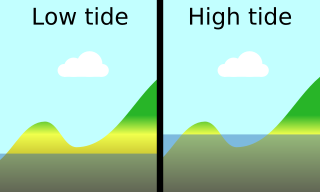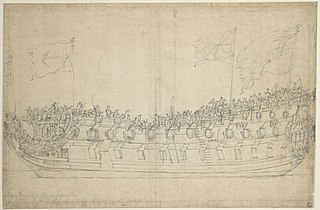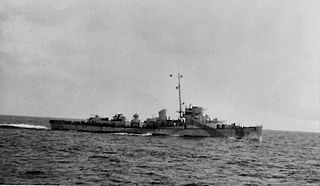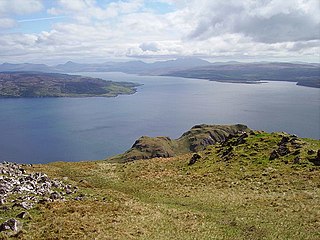
Tobermory is the capital of, and until 1973 the only burgh on, the Isle of Mull in the Scottish Inner Hebrides. It is located on the east coast of Mishnish, the most northerly part of the island, near the northern entrance of the Sound of Mull. The village was founded as a fishing port in 1788; its layout was based on the designs of Dumfriesshire engineer Thomas Telford. It has a current population of about 1,000.

A tidal island is a piece of land that is connected to the mainland by a natural or man-made causeway that is exposed at low tide and submerged at high tide. Because of the mystique surrounding tidal islands, many of them have been sites of religious worship, such as Mont-Saint-Michel with its Benedictine Abbey. Tidal islands are also commonly the sites of fortresses because of their natural fortifications.

HMS A1 was the Royal Navy's first British-designed submarine, and their first to suffer fatal casualties.

Mingary Castle, also known as Mingarry Castle, is a castle situated one mile southeast of the small village of Kilchoan in Lochaber, Scotland. Nestled on ridge of rock overlooking the sea, it was considered a strategically important site in terms of communication with overseas areas and as an entranceway to the Sound of Mull. Mingary is roughly hexagonal in shape with nine-foot-thick walls, thicker on the seaward side. The remains of the castle are protected as a category A listed building.

HMS Stirling Castle was a 70-gun third-rate ship of the line of the English Royal Navy, built at Deptford in 1679. She underwent a rebuild at Chatham Dockyard in 1699. She was wrecked on the Goodwin Sands off Deal on 27 November 1703. The wreck is a Protected Wreck managed by Historic England.

HMS Pomone was a 38-gun Leda-class fifth rate of the Royal Navy launched in 1805. She saw action during the Napoleonic Wars, primarily in the Mediterranean while under the command of Captain Robert Barrie. She was wrecked off The Needles, part of the Isle of Wight, in 1811. The wreck is a Protected Wreck managed by Historic England.

HMS Dartmouth was a small frigate or fifth-rate ship, one of six ordered by the English Council of State on 28 December 1654 and built in 1655.
SM UB-65 was a Type UB III U-boat of the Imperial German Navy during World War I. Ordered on 20 May 1916, the U-boat was built at the Vulkan Werke shipyard in Hamburg, launched on 26 June 1917, and commissioned on 18 August 1917, under the command of Kapitänleutnant Martin Schelle.

HMS Lawford (K514) was a Royal Navy converted Captain class frigate, built in the US in 1944. She was converted into an HQ ship for the Normandy landings. On 8 June 1944, whilst operating off Juno Beach, she was hit by enemy fire during an air attack and sunk. Thirty-seven of her crew died. The Royal Navy's damage summary report states that the ship was hit by an "aerial torpedo", which has been taken to mean a torpedo dropped from an aircraft. However, a survey of the ship undertaken as part of the Channel 4 TV series "Wreck Detectives" found evidence that the vessel was broken up and sunk by an internal explosion, indicating a hit from one or more bombs or from an early guided missile such as an Hs-293 or a Fritz X.
HMS Pylades was a Catherine-class minesweeper of the Royal Navy.

HMS Duckworth (K351) was a Captain-class frigate of the Royal Navy. She served during the Second World War as a convoy escort and anti-submarine warfare vessel in the Battle of the Atlantic and was an effective U-boat killer, being credited with the destruction of five U-boats during the conflict.

HMS Blackwood was a Captain-class frigate of the Evarts-class of destroyer escort, originally commissioned to be built for the U.S. Navy. Before she was finished in 1942, she was transferred to the Royal Navy under the terms of Lend-Lease, and saw service during the Second World War.
SS Rosehill, also known as SS Penhill, was a 2,788 GRT steel-hulled collier built in 1911 by S.P. Austin and Son of Sunderland under the name Minster. She was torpedoed by the Imperial German Navy submarine UB-40 in the English Channel off Fowey, Cornwall, England, on 23 September 1917 while en route from Cardiff, Wales, to Devonport. She was taken under tow but sank in Whitsand Bay at 18:05. Her wreck lies in 28 metres of water at 50°19.793′N4°18.520′W with her bow to the north.

The Battle of Ushant, also known as the Battle of Brittany, occurred on the early morning of 9 June 1944 and was an engagement between German and Allied destroyer flotillas off the coast of Brittany. The action came shortly after the initial Allied landings in Normandy. After a confused engagement during the night the Allies sank one of the German destroyers and forced another ashore, where she was wrecked.

The Sound of Mull is a sound between the Inner Hebridean island of Mull and mainland Scotland. It forms part of the Atlantic Ocean.

Innes McCartney is a British nautical archaeologist and historian and a Research Fellow at Bournemouth University.
The following index is provided as an overview of and topical guide to Wikipedia's articles on recreational dive sites. The level of coverage may vary:

Recreational dive sites are specific places that recreational scuba divers go to enjoy the underwater environment or for training purposes. They include technical diving sites beyond the range generally accepted for recreational diving. In this context all diving done for recreational purposes is included. Professional diving tends to be done where the job is, and with the exception of diver training and leading groups of recreational divers, does not generally occur at specific sites chosen for their easy access, pleasant conditions or interesting features.

HMS Cam (K264) was a River-class frigate of the Royal Navy (RN) from 1944–1945. She served in convoy defence duties in the North Atlantic during World War II. Cam was built to the RN's specifications as a Group II River-class frigate, though Cam was one of the few powered by a turbine engine.